Make fresh Homemade Mochi (Japanese rice cakes) using a stand mixer and an electric rice cooker! Stuff the mochi with your favorite dessert filling, dip it in a savory or sweet coating, or enjoy it in red bean soup or Japanese New Year soup (ozoni).
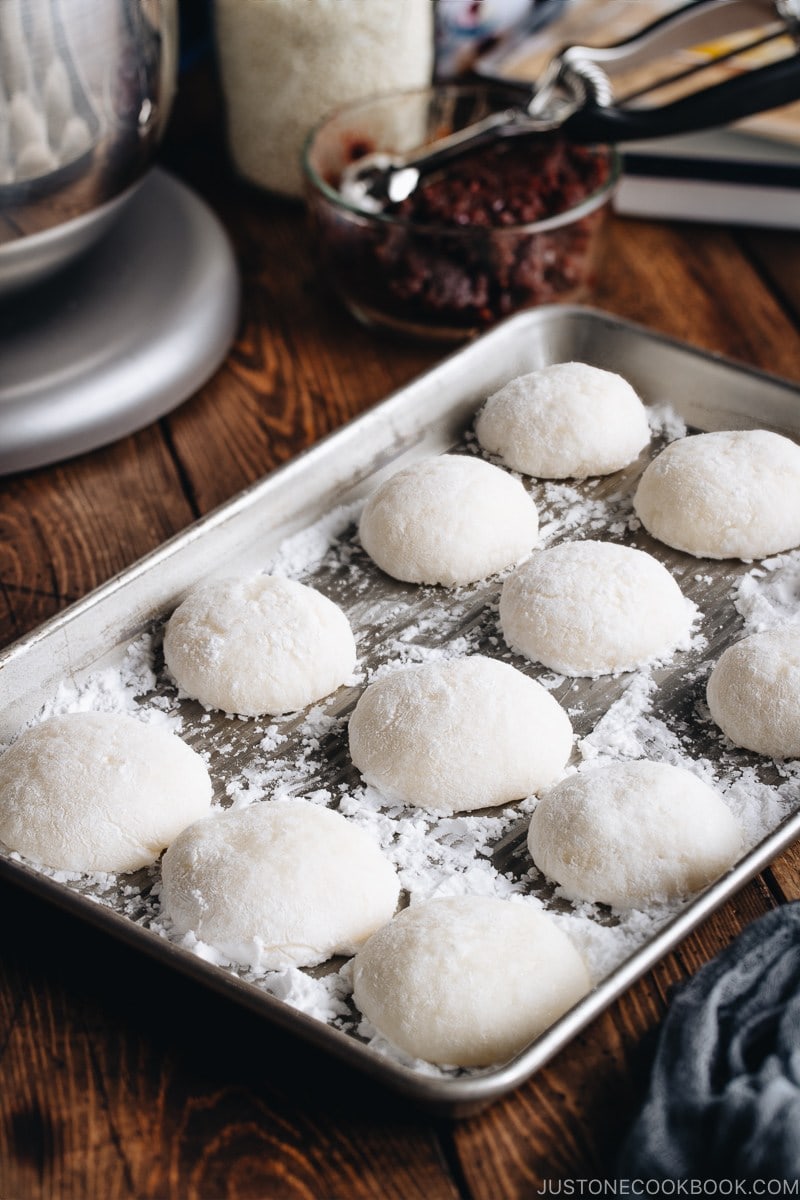
Sticky and chewy Mochi (餅) is irresistible. Whether it’s Mochi Ice Cream, Strawberry Daifuku Mochi, or mochi enjoyed during traditional Japanese New Year, these elastic wonders of glutinous rice cakes have captured the hearts of people worldwide. In the US, you can even find the mainstream mochi creations at major grocery stores like Trader’s Joe and Whole Foods.
Today I’ll show you how to make fresh homemade mochi with a rice cooker and a stand mixer. It is a fairly easy affair, but I do want to warn you – mochi is super sticky and the process can be a handful. Don’t let that stop you though because there is nothing like eating freshly pounded mochi! They are smooth, springy, and tactile. A nostalgic reminder of my childhood and all the happy memories in Japan.
Table of Contents
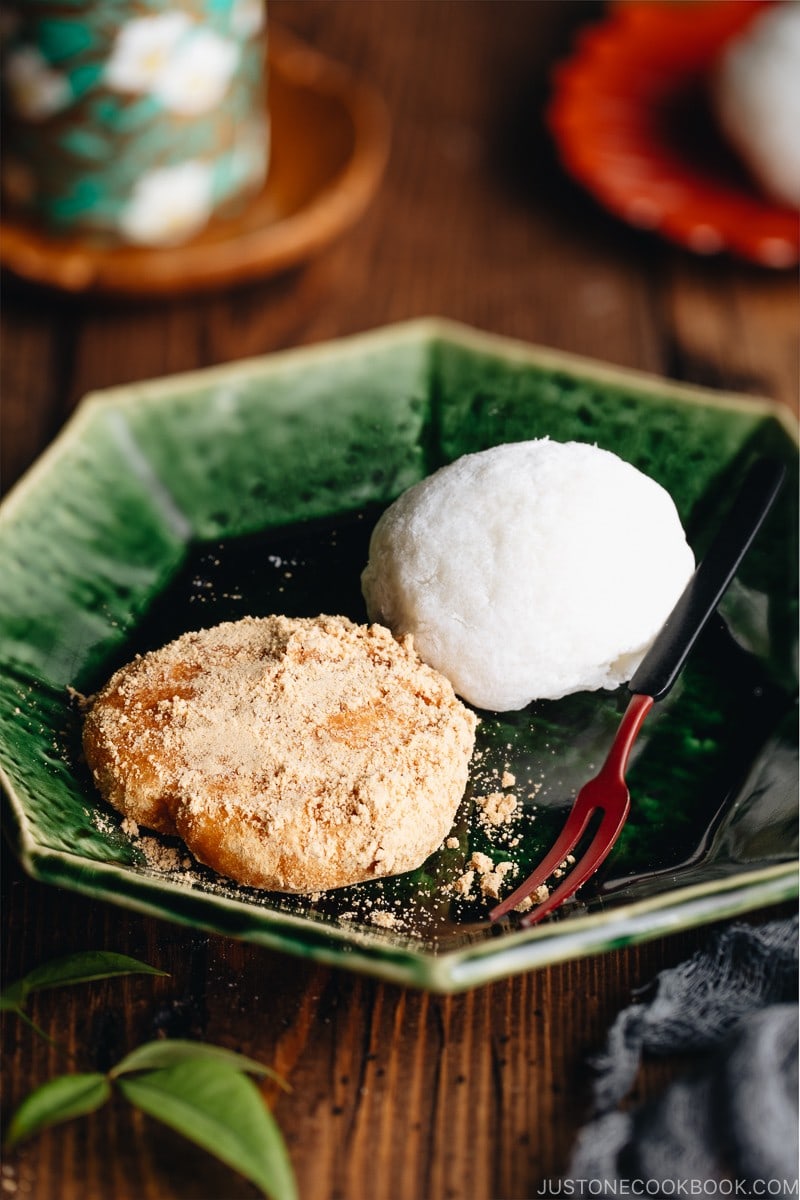
What is Mochi?
A fun fact: Mochi (餅, もち) is often pronounced as [MO-chi] in English, but we actually pronounce it [mo-CHI] in Japanese.
Mochi is a Japanese rice cake made of mochigome (糯米), a short-grain glutinous rice*. It’s naturally white, sticky, elastic, and chewy. It tastes like rice without filling or coating, but mochi is all about the texture. There is no other food that has this unique texture similar to mochi.
Outside of Japan, mochi seems to be associated with desserts like mochi ice cream and mochi stuffed with a sweet filling. However, when the Japanese hear the word “mochi”, it usually implies the plain mochi that can be used for both savory and sweets. Think of it this way: if steamed rice is one form of rice, then mochi is another form of rice.
*It’s sometimes called “sweet rice” although they both mean the same thing. I’d just call “glutinous rice” in this post.
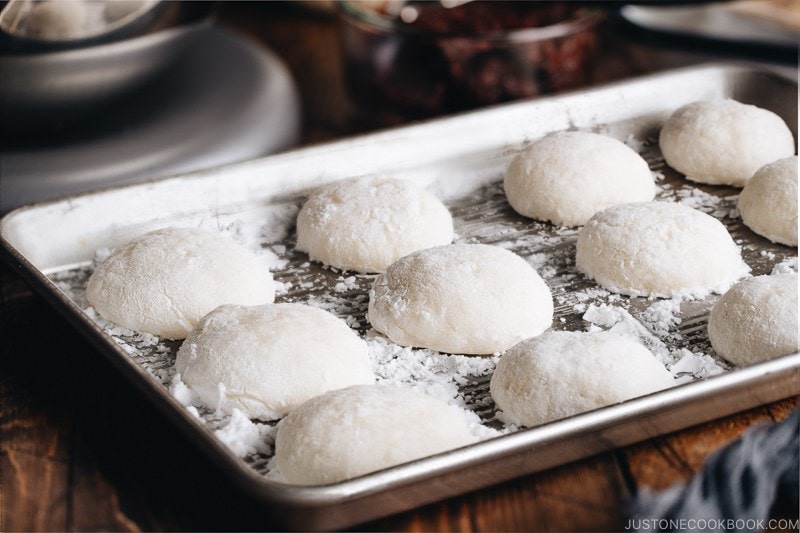
How Mochi is Made
Traditionally, glutinous rice is first steamed, then transferred into a usu (臼), a large Japanese stamp mill, and pounded with a pestle called kine (杵). This mochi-pounding event is called mochitsuki (餅つき).
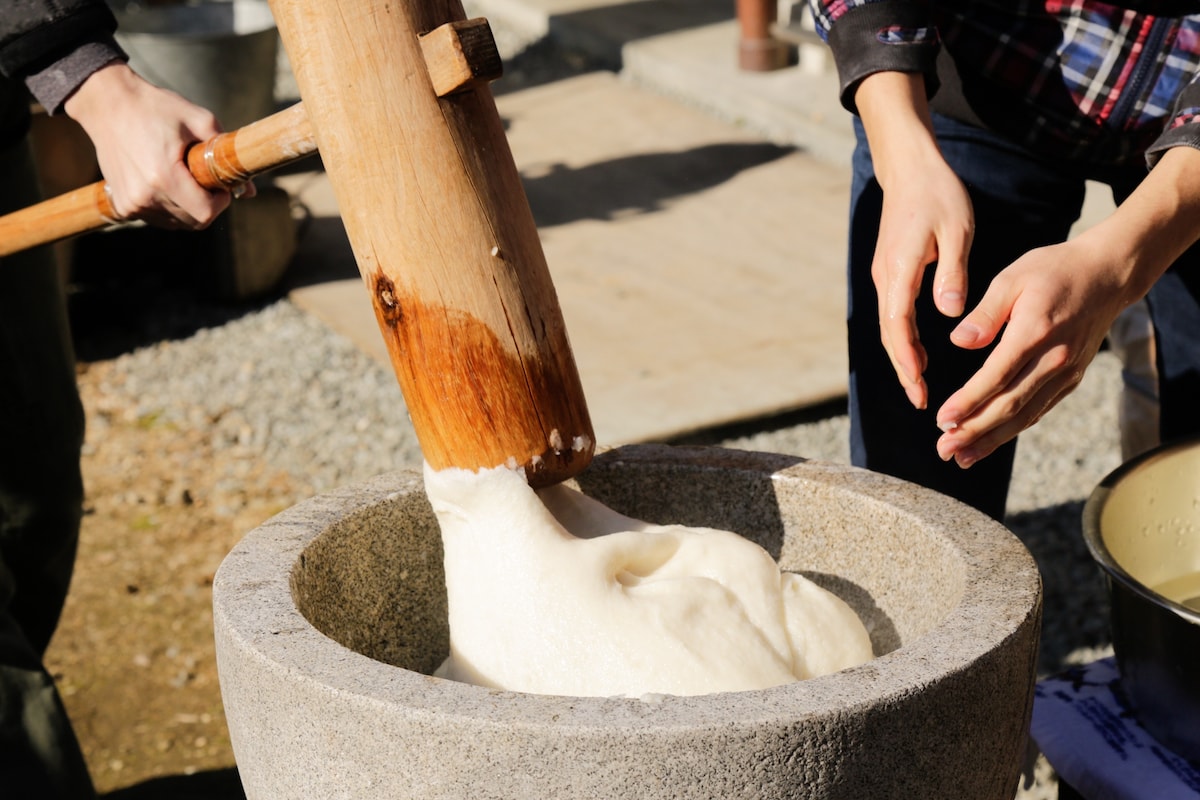
The glutinous rice is pounded repeatedly until smooth, sticky, and elastic. Some households own a bread machine with a “mochi making” function, which can cook and pound the glutinous rice (Isn’t it genius?). Some people even own a mochi-pounding machine. Outside the big cities, people still make mochi the traditional way using the family’s heirloom usu and kine. Mochitsuki is a family event that they continue on.
After the mochi is pounded, it is transferred to a working station where you shape it into round mochi balls or make big round pieces used for a decoration called kagami mochi (鏡餅) during the Japanese New Year. Making mochi is a big part of Japanese New Year preparation.
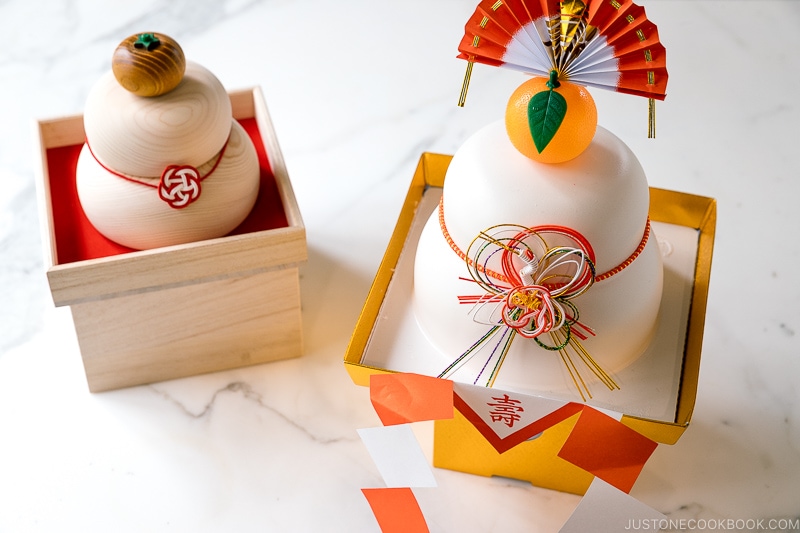
Today we will make fresh mochi with a rice cooker and a stand mixer!
Keep in Mind:
- Mochi is an extremely sticky food. Embrace the gooeyness and have fun!
- Don’t touch mochi with your bare hands/utensils. When kneading and pounding, always wet your hands and utensils. When shaping mochi, make sure your hands are dry and lightly dusted with starch.
- Soak the bowls and tools in water immediately. Mochi will come off easily by the time you clean up.

How to Make Mochi with a Stand Mixer (3 Steps)
- Cook glutinous rice in a rice cooker (or whatever method you use) – Easy
- “Knead” and “Pound” the cooked rice with a stand mixer. – Fairly easy
- Divide and make mochi balls – Mess alert! (just kidding, you can do it)
Note: Instead of using mochiko (glutinous rice flour), we will cook glutinous rice to make the dough in this recipe so it yields the freshest taste.
Step 1: Cook Glutinous Rice
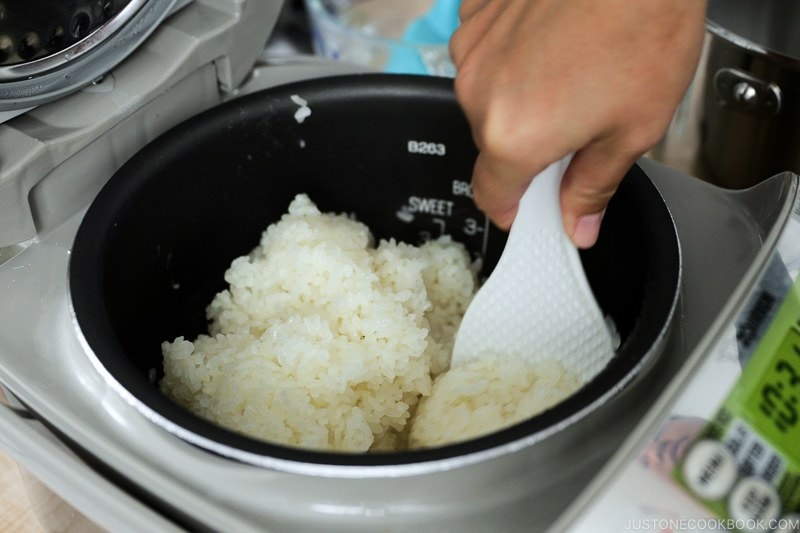
I decided to use a rice cooker method since it’s a standard electric appliance if you cook Japanese or Asian food frequently.
Rice Cooker: You do not need to soak the glutinous rice in water prior to cooking. Just rinse and cook the glutinous rice just like you would with regular steamed rice.
Steamer: Traditionally, glutinous rice is steamed in a steamer because it’s considered the best way. You would rinse and soak the rinsed glutinous rice in water overnight, put the rice in cheesecloth, place it inside the steamer, and steam for 30 minutes.
Instant Pot: You can use your Instant Pot if you have one. Soak the glutinous rice for 1 hour after rinsing, high-pressure cook for 5 minutes, and natural release for 15 minutes.
Pot on Stove: Rinse the glutinous rice, soak for 10 minutes, then put the rice and water in the pot. Start with high heat, and once boiling, mix the rice once and put the lid on. Turn the heat down to the lowest setting and cook for 8-10 minutes. Remove from the heat and let it steam for 10-15 minutes.
Step 2: “Knead” and “Pound” Using a Stand Mixer
At this step, you will need a few things:
- A KitchenAid® stand mixer – Professional series (This is the only appliance that I’ve tried making mochi successfully many times)
- A timer (your smartphone would do)
- Hot water ready for use
- Silicone spatula (A flexible silicone spatula is easy to scrape down the mochi in the stand mixer)
- A 2-cup measuring cup for soaking the spatula
This stand mixer process involves 2 stages:
- Knead with a dough hook for 3 minutes – repeat 4 times [total 12 minutes]
- “Pound” with a flat beater for 30 seconds – repeat 4 times [total 2 minutes]
Step 3: Shaping Mochi Balls
Here’s what you’re going to do:
1. Prep your work surface and two rimmed baking sheets. Thinly coat the mochi dough with potato starch (or cornstarch).
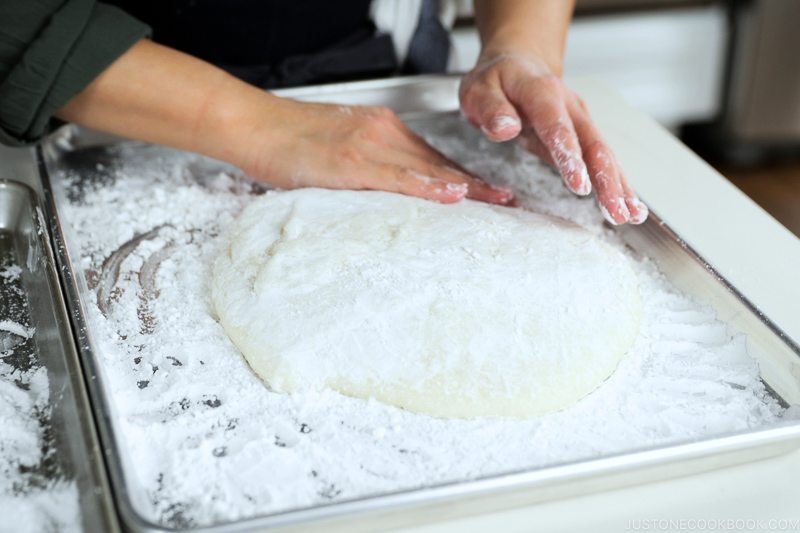
2. Pull up a corner and tuck in the edges underneath to create a small mound. Keep pulling and tucking until it’s thick enough.
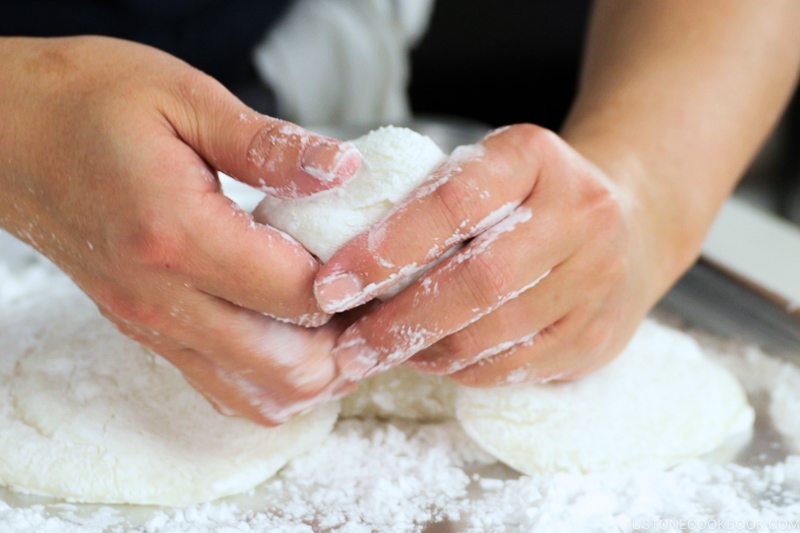
3. Make a “C” with your well-dusted, left pointing finger and thumb, and then place the “C” fingers on top of the thick corner.

3. With your right hand, tuck and squeeze the mochi into the left “C” fingers from underneath and side to make a ball shape.
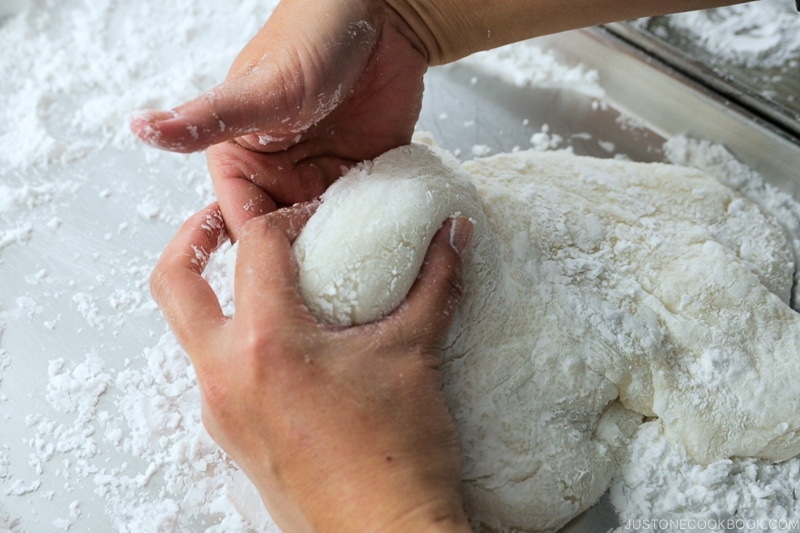
4. Once you get a good-size ball shape that’s slightly bigger than a golf ball, pinch the mochi with your left “C” fingers. Use the right hand to twist it off.
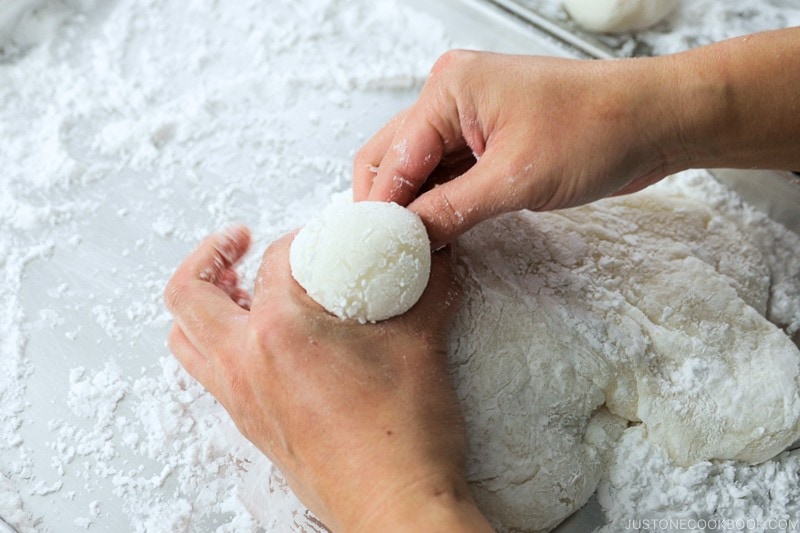
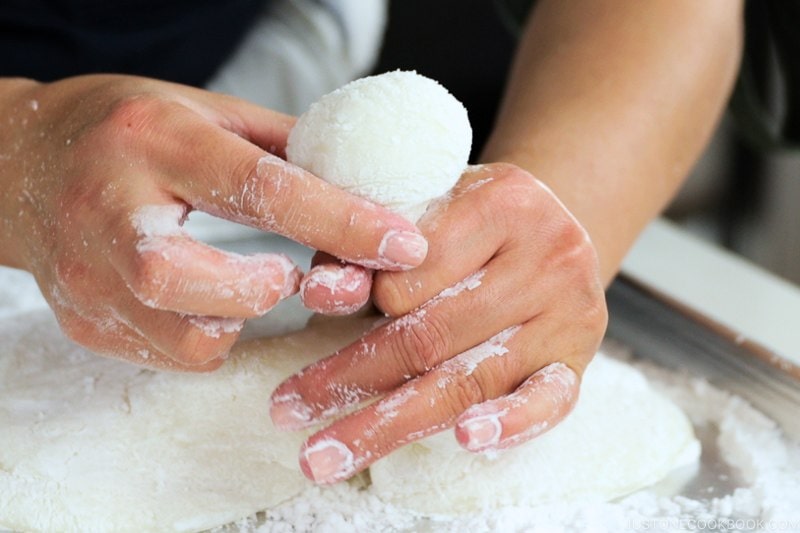
When pinching, do not pull the mochi because the sticky surface would appear and your hands would get messy. Instead, use a pinch & twist motion to cut the mochi with two “C” fingers and right hand. Make sure your hands are dry and well-dusted with potato starch.
5. Quickly rotate the mochi on dusted hand to cover up the sticky new surface.
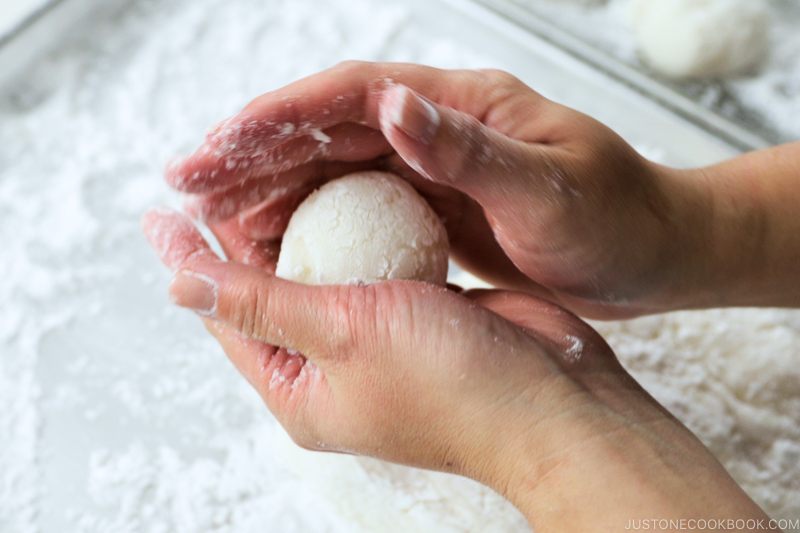
REMINDER:
- Handle the areas dusted by starch only and make sure your hands are dry and well-dusted.
- Do not to “pull” the mochi, which creates a fresh sticky surface.
- If you see any sticky surface appearing on mochi, lightly dust a thin layer of starch and brush the excess away. Too much starch would be troublesome when you stuff the filling and close the mochi.
*Please watch my video. Sometimes it’s easier to see in action than reading my instructions.
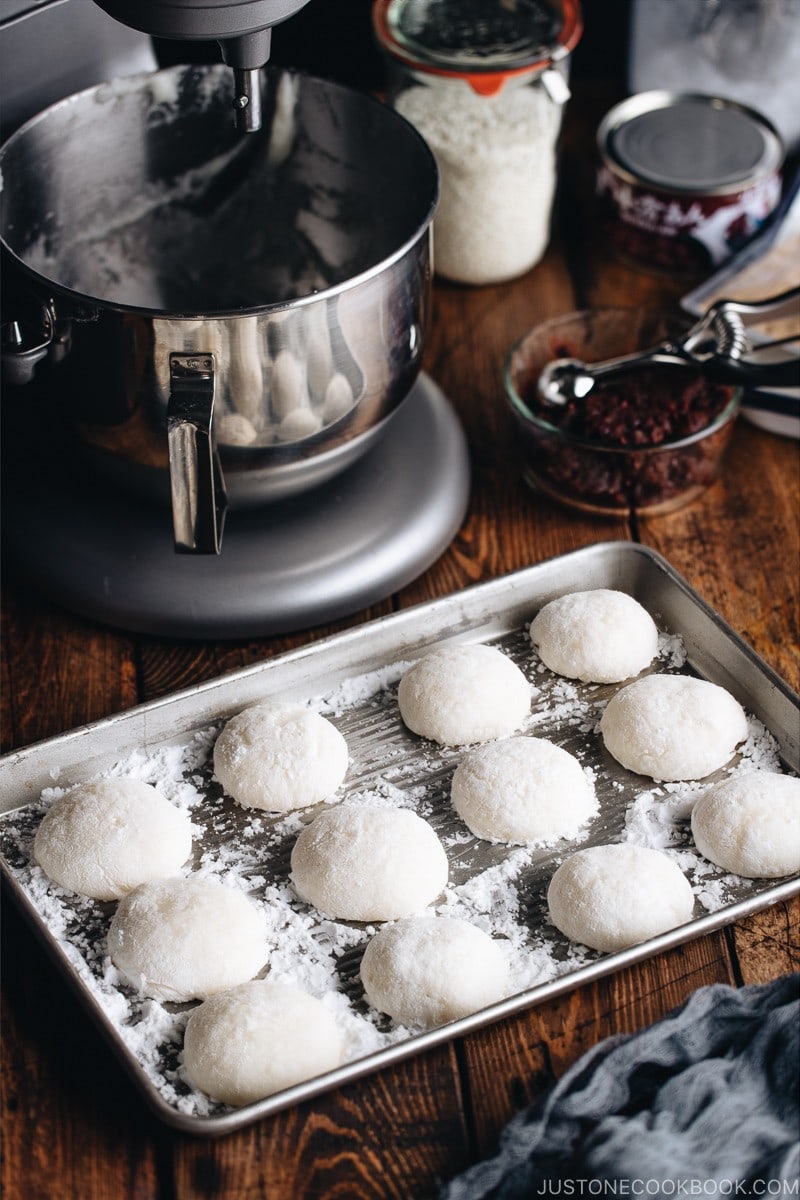
5 Ways to Enjoy Homemade Mochi
There are so many ways to enjoy fresh homemade mochi. Here are some common ways to enjoy it.
1. Put mochi in a soup
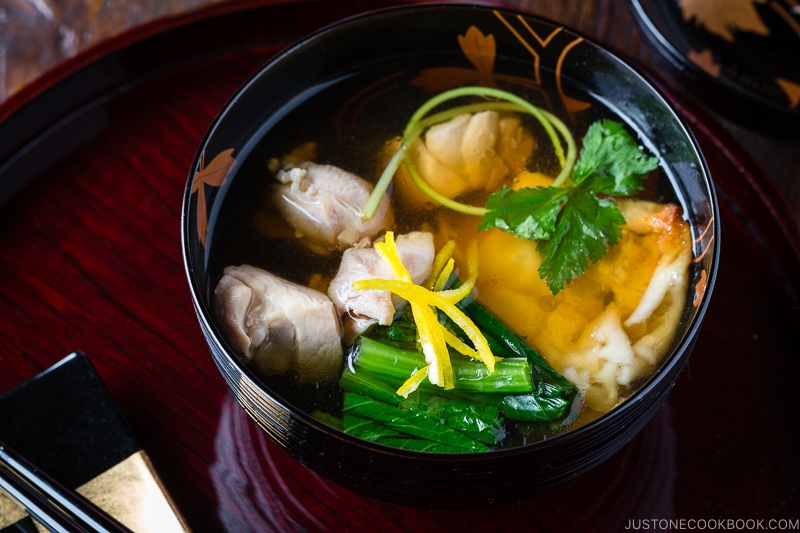
- Kanto (Tokyo)-style Ozoni (New Year Soup)
- Kansai (Osaka)-style Ozoni (New Year Soup)
- Zenzai/Oshiruko (Red Bean Soup)
2. Stuff mochi with a sweet filling

- Anko (Red bean paste) – See the recipe below
- Make the best mochi ice cream with flavors like matcha, strawberry, chocolate, and mango.
3. Coat mochi with a sweet/savory sauce
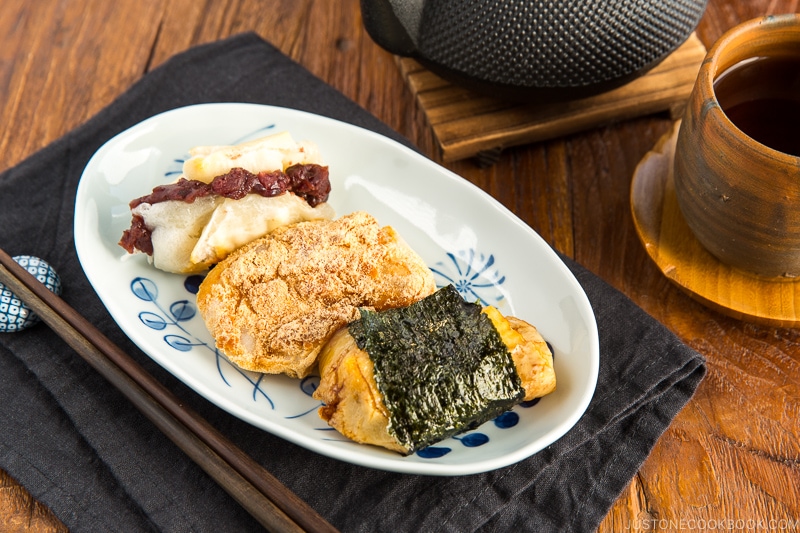
- Kinako (soybean flour) + sugar – See the recipe below
- Soy sauce + sugar
- Anko (sweet red bean paste) – Pressure Cooker Anko or Stovetop Anko
4. Make mochi into Japanese New Year decoration
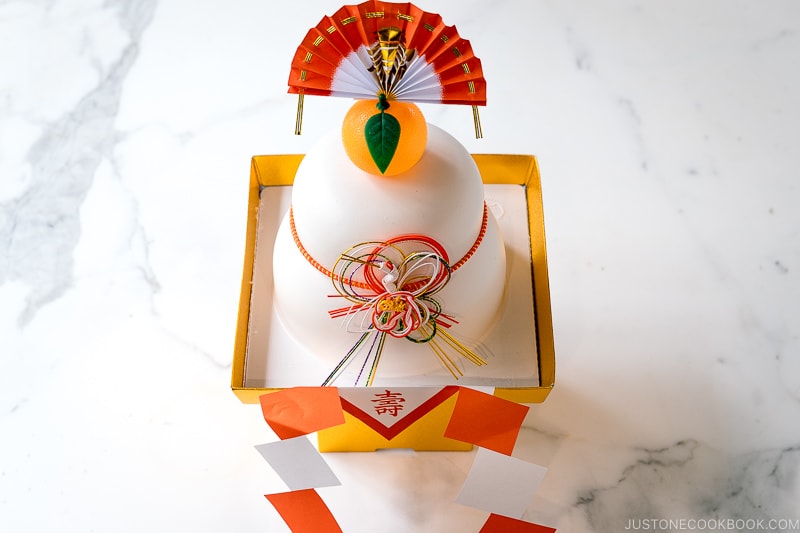
- Kagami Mochi (decorate until 1/15)
5. Make mochi into rice crackers
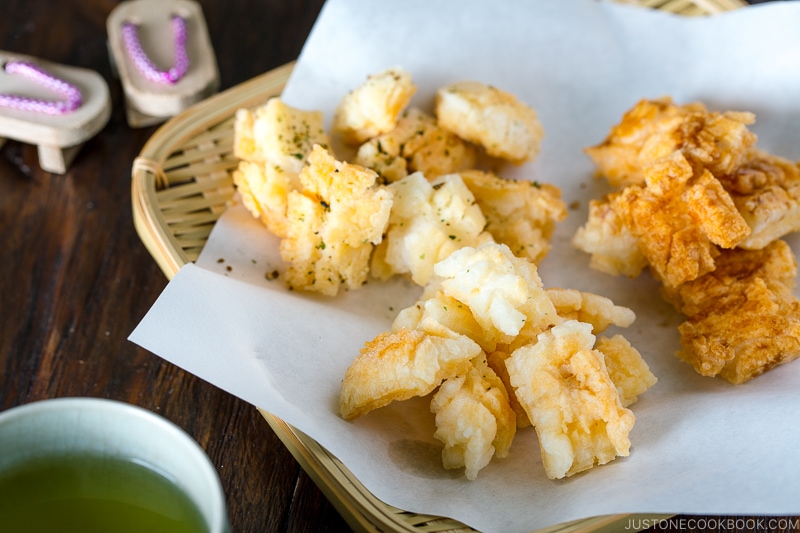
- Make it flat and air dry until completely dry. Then toast the mochi on both sides in the oven. Brush with soy sauce and air dry. See my Rice Cracker (Kaki Mochi) recipe.
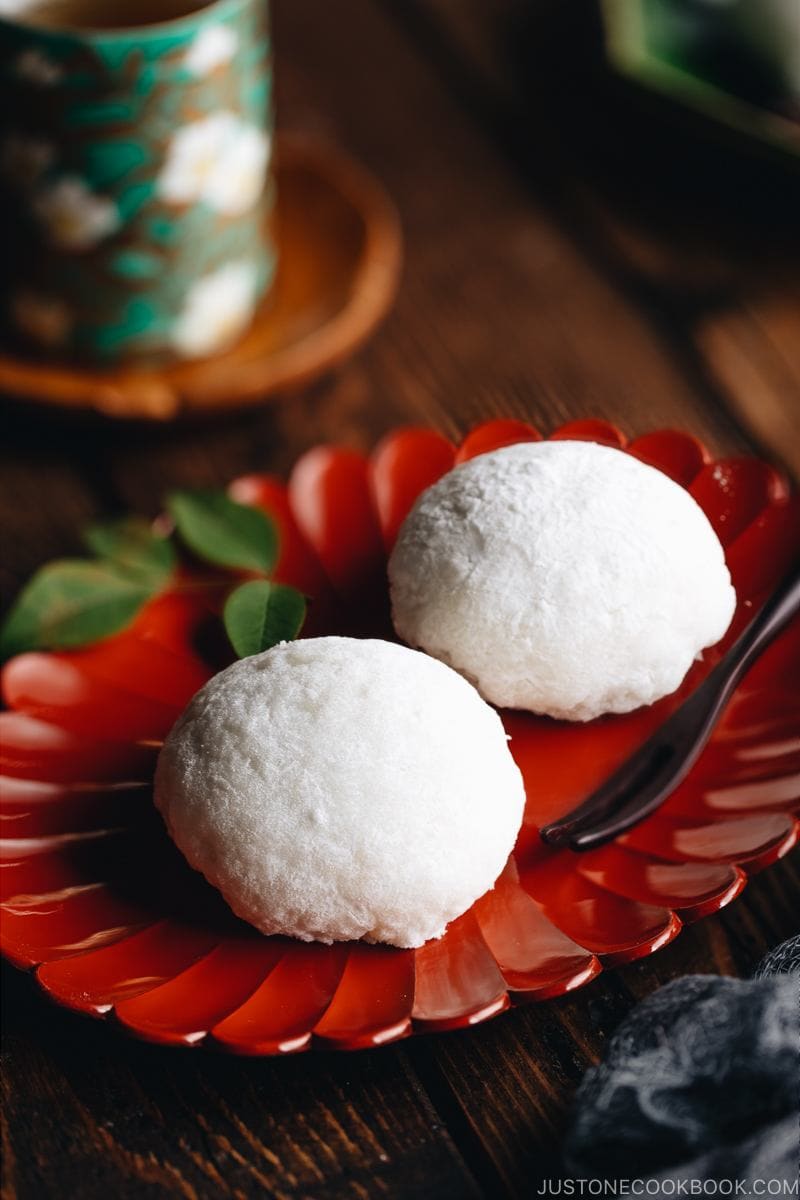
Frequently Asked Questions
1. Can I use other types of rice?
No, for this recipe, I only tried with Japanese short-grain glutinous rice (sweet rice) or what we call, mochigome (もち米).
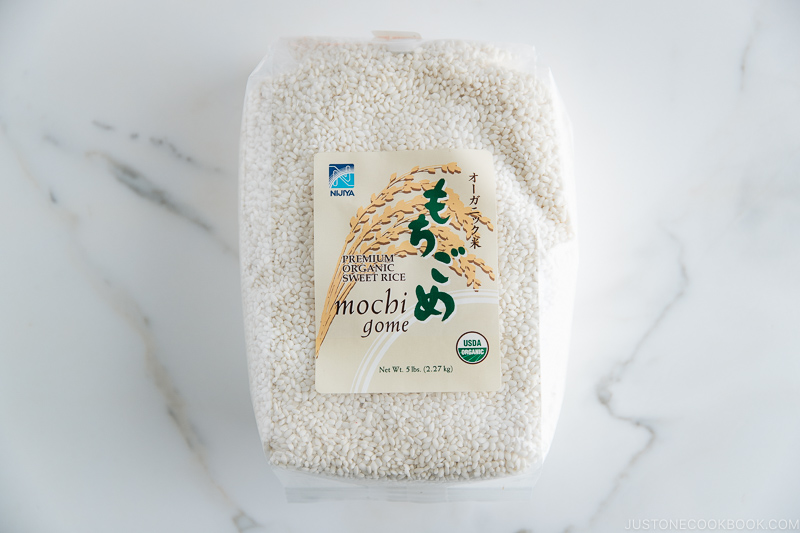
I had never tried other types of rice such as long-grain glutinous rice, therefore I would not know how much water you need to cook the rice, how long it takes to knead/beat, etc.
2. Can I make a bigger batch?
To be honest, I am not so sure because I don’t think my Kitchen Aid stand mixer would be able to knead more mochi inside the bowl. With 3 rice cooker cups of glutinous rice, it was working hard, and I wouldn’t feel comfortable doing even a bigger batch. So I would suggest making a few batches.
3. How can I keep mochi softer for a long time?
The answer is sugar. If you plan to make sweet mochi such as daifuku mochi, then you should add sugar. I researched, and it recommends using 50-100 grams of sugar for 100 grams of cooked glutinous rice. You will need to add sugar while you’re kneading the mochi. Start with 50 grams and increase the amount as you like. The more sugar you added, the longer the mochi stays soft.
4. Can I freeze the mochi? How long does it last?
Yes, you can freeze the mochi! For the best quality, eat it within a month, but mochi can be kept in the freezer for 6 months if you store them well.
5. Does it taste like freshly pounded mochi made with the traditional method using usu and kine?
I wish! The stand mixer cannot do a real “pounding” motion and the mochi is not 100% made in the same way. However, if my choice was between store-bought mochi vs. homemade mochi, I would choose to make fresh mochi in my stand mixer. It is actually amazing! The mochi’s texture is 95% close to the ones made traditionally. I just wish that it yields a real smooth and silky surface. That said, the difference is not obvious.
Ready to make some mochi from scratch? Time to gather your kids or mochi-loving friends for this sticky, fun and auspicious activity!
Other Mochi Recipe
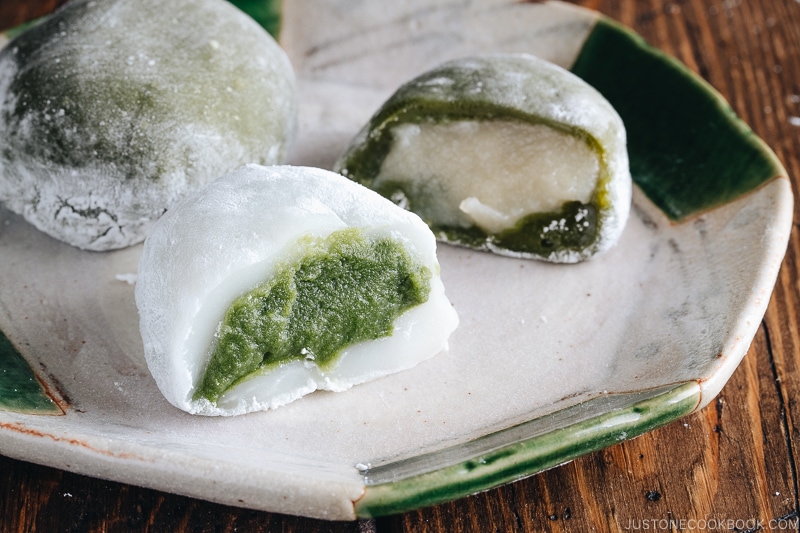
Matcha Green Tea Mochi – This recipe uses glutinous rice flour and matcha powder, and it’s perfectly chewy with a hint of earthy sweetness.
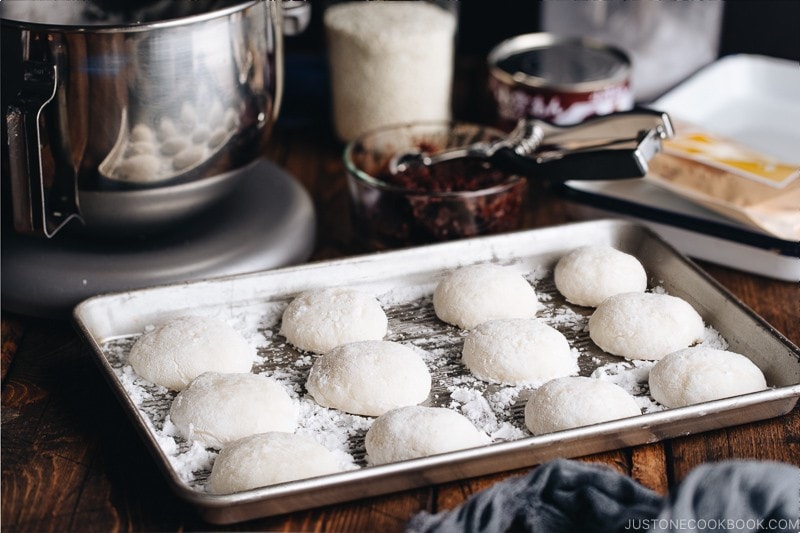
Wish to learn more about Japanese cooking? Sign up for our free newsletter to receive cooking tips & recipe updates! And stay in touch with me on Facebook, Pinterest, YouTube, and Instagram.
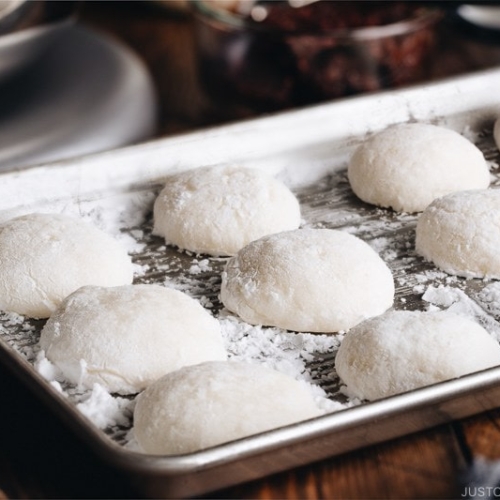
How to Make Mochi with a Stand Mixer
Video
Ingredients
- 2¼ cups sweet rice/glutinous rice (mochigome) (or 3 rice cooker cups)
- 1⅔ cups water (in your rice cooker, the water level should reach the line on the inner pan for 3 rice cooker cups of Sweet Rice)
- potato starch or cornstarch (for dusting)
For the Anko Mochi (optional)
- sweet red bean paste (anko) (store bought, or you can make my Homemade Anko or Pressure Cooker Anko)
For the Kinako Mochi (optional)
- 2 Tbsp kinako (roasted soybean flour) (enough for 2 mochi balls; follow a ratio of 2 parts kinako to 1 part sugar)
- 1 Tbsp sugar
Instructions
Before You Start…
- I created this recipe using the KitchenAid Professional series stand mixer. I cannot guarantee that other equipment will work, as I have not tested it. Please do not use a hand mixer to make this recipe, as the motor is not powerful enough to handle mochi. You can always pound the cooked glutinous rice with a wooden mallet.
To Measure and Rinse the Glutinous Rice
- Measure 2¼ cups sweet rice/glutinous rice (mochigome). Tip: One rice cooker cup (180 ml) of uncooked glutinous rice is 150 g or ¾ US cup. You will need 3 rice cooker cups (540 ml, 450 g) for this recipe.

- To rinse the glutinous rice, put the rice in a large bowl and add some water. Stir with your hands and quickly drain the water.

- Then, gently stir the rice with your fingertips. Glutinous rice breaks easily, so do not apply any extra pressure. Just lightly stir it a few times.

- Add more water to the bowl and carefully rinse. Repeat rinsing 3–4 more times. Drain the rice in a fine-mesh sieve.

- Shake the sieve to remove the excess water. Then, transfer the rice to the inner pot of a rice cooker.

- Even the level of the rice in the pot and add 1⅔ cups water. The water level should be at the inner pot‘s 3-cup line for Sweet Rice. Evenly distribute the rice with chopsticks or your fingers.

To Cook the Glutinous Rice
- Close the lid of the rice cooker. Select Regular on the menu and start cooking. Regular mode cooking is usually 5–10 minutes longer than the Sweet Rice setting. When the rice is finished cooking, we can take it out immediately.

- When the rice is almost done, prepare about 4–5 cups of boiling water. Once the hot water is ready, pour one-third of the boiled water into your stand mixer bowl to warm it up, one-third into a mixing bowl to warm a dough hook and flat beater, and the rest into a 2-cup measuring cup to keep a silicone spatula wet. Make sure there is enough hot water to submerge all the tools.

- Once the mixer bowl is warm, discard the hot water. Then, transfer all the cooked glutinous rice into the stand mixer bowl.

To Knead with the Dough Hook Attachment
- Set the dough hook attachment on the stand mixer. Start kneading the glutinous rice on Speed 2. Set a timer for 3 minutes (first round).

- The dough hook will start pulling in the rice.

- Tip: While kneading, you can use your wet silicone spatula to detach the glutinous rice from the wall of the stand mixer bowl.

- When the 3-minute timer beeps [03:00], remove the bowl from the stand mixer, keeping the dough hook attached. Using the wet silicone spatula, flip over the glutinous rice. Dip the spatula in the water a few times so it doesn’t stick to the rice.

- Set the bowl back onto the stand mixer and start kneading again on Speed 2. Reset the timer for 3 minutes (second round).

- When the 3-minute timer beeps [06:00], remove the bowl from the stand mixer and flip the glutinous rice again, using the wet silicone spatula. Now, the rice grains are less visible and are starting to look like mochi.

- Put the bowl back onto the stand mixer and start kneading again on Speed 2. Reset the timer for 3 minutes (third round).

- When the 3-minute timer beeps [09:00], remove the bowl from the stand mixer and flip the glutinous rice again, using the wet silicone spatula. Now it’s getting stickier and elastic.

- Put the bowl back onto the stand mixer and start kneading again on Speed 2. Reset the timer for 3 minutes (fourth round).

- When the 3-minute timer beeps [12:00], remove the bowl from the stand mixer and flip the glutinous rice again, using the wet silicone spatula. Now the kneading is complete.

To “Pound“ with a Flat Beater Attachment
- Remove the dough hook attachment from the stand mixer and change to a flat beater attachment.

- Beat the mochi on Speed 3. Set the timer for 30 seconds (first round).

- When the 30-second timer beeps [00:30], do not remove the bowl from the stand mixer. Scrape the mochi as much as you can from the sides of the bowl, using the wet silicone spatula.

- Reset the timer for 30 seconds (second round). Start beating again on Speed 3. When the 30-second timer beeps [01:00], scrape the mochi again from the sides of the bowl, using the wet silicone spatula.

- Reset the timer for 30 seconds (third round). Start beating again on Speed 3. When the 30-second timer beeps [01:30], scrape the mochi again from the sides of the bowl, using the wet silicone spatula.

- Reset the timer for 30 seconds (fourth round). Start beating again on Speed 3. When the 30-second timer beeps [02:00], scrape the mochi again from the sides of the bowl, using the wet silicone spatula. Now, the pounding is done.

To Shape into Mochi Cakes
- Prepare two rimmed baking sheets by covering them with potato starch or cornstarch. Put all the pounded mochi on one of the baking sheets. The other one is for keeping the mochi cakes.

- Sprinkle some potato starch on top of the freshly pounded mochi. Make sure your hands are completely dry and dust them with potato starch. Keep extra starch handy so you can always dust your hands when needed.

- Spread the potato starch on top of the mochi, making sure there is no sticky part exposed. While the mochi is still hot, but cool enough to handle, pick up a corner of the mochi and start tucking in the edges underneath. Tip: Work quickly while the mochi is still quite warm. As it cools down, it will firm up and harden and be impossible to shape.

- Once you’ve mounded up a thick layer of mochi, make a C shape with your left index finger and thumb against the edge of the mochi.

- Use your right hand to tuck in and push up the mochi underneath to create a ball shape above your left C-shaped fingers.

- Pinch and twist: Using your C-shaped fingers, pinch underneath the ball to cut off the mochi. Use your right hand to twist off the mochi. Do not pull the mochi, as it creates a sticky surface.

- This photo is a bad example. You don’t want to pull the mochi. The sticky mochi surface appears and now your hands get sticky when you touch it. REMEMBER: Pinch and twist. Pinch and twist.

- As you form the mochi cakes, place them on the other rimmed baking sheet. When you're ready to eat them, dust off the starch with a pastry brush or with your dry hands. Enjoy your mochi in Japanese New Year Soup (Ozoni) and Red Bean Soup, or make Anko Mochi or Kinako Mochi (see below).

To Store
- If you do not use the mochi cakes immediately, let them cool completely, then cover each one individually in plastic wrap and put in a freezer bag. Store in the freezer for 3 months.

To Make the Anko Mochi (optional)
- Prepare the Anko Mochi while the mochi cakes are still warm. First, flatten the cakes by pressing down with the palm of your hand.

- Brush off the excess starch with a pastry brush or your dry hands. It’s important to remove the starch, so don’t skip this step.

- Put a scoop of sweet red bean paste (anko) in the center of each mochi. Pull two opposite sides of the mochi out and away from the center.

- Pull up the sides and pinch the ends over the anko. Repeat for the other sides and pinch the ends together on top.

- Lightly dust your hands with potato starch (do not coat too heavily). Use light pressure to pinch and seal the top of the mochi. Repeat with the rest of the mochi pieces. Serve immediately.

To Make the Kinako Mochi (optional)
- Prepare the Kinako Mochi while the mochi cakes are still warm. In a bowl, combine 2 Tbsp kinako (roasted soybean flour) and 1 Tbsp sugar and mix well. This is enough kinako mixture for 2 mochi cakes.

- Pour some hot water in a separate bowl. Use chopsticks to dip a mochi cake in the hot water.

- Then, dip the mochi in the kinako mixture and coat well. Repeat with the rest of the mochi pieces. Serve immediately.

Nutrition
Editor’s Note: This post was originally published on December 19, 2018. It’s been re-published with more information on December 23, 2023.
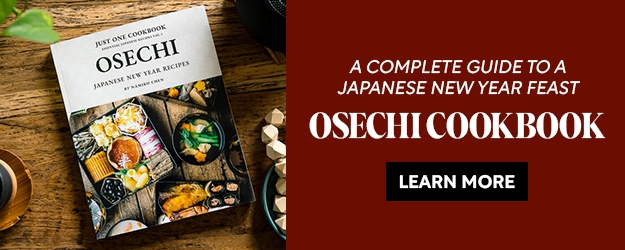
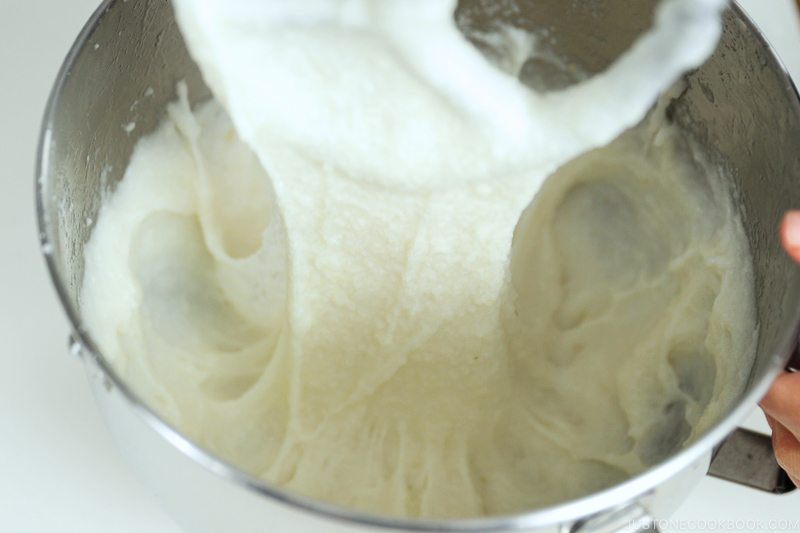

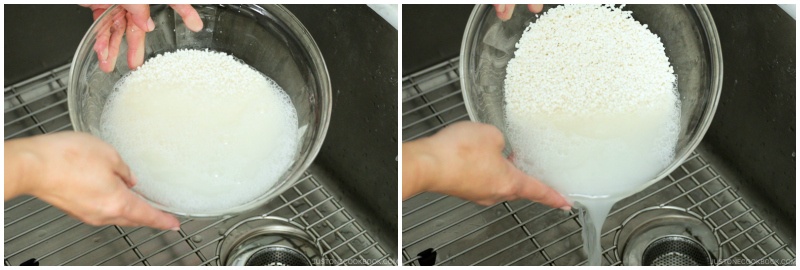
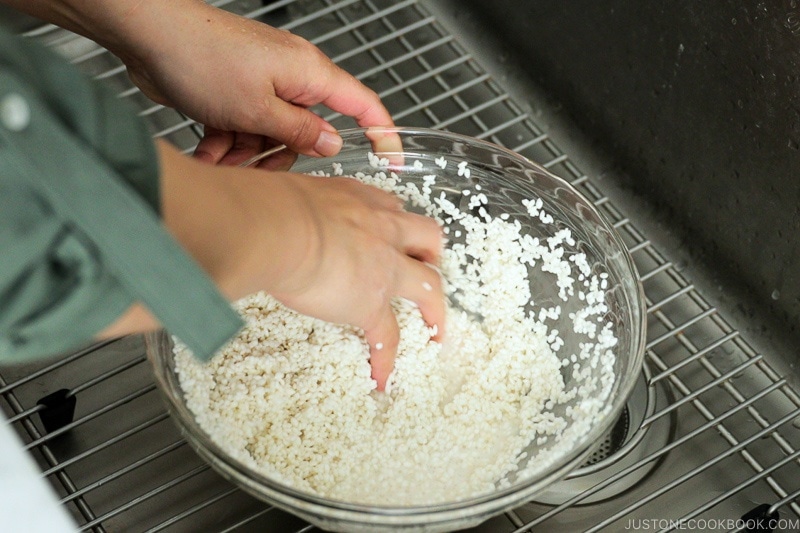
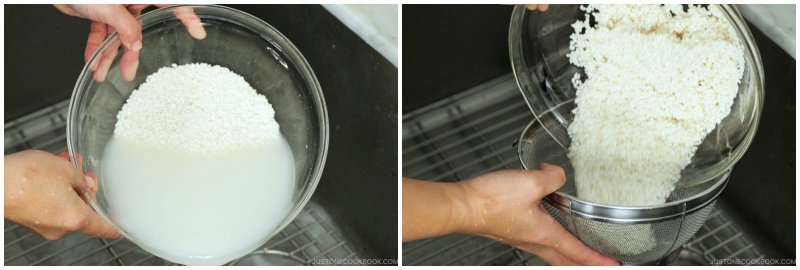
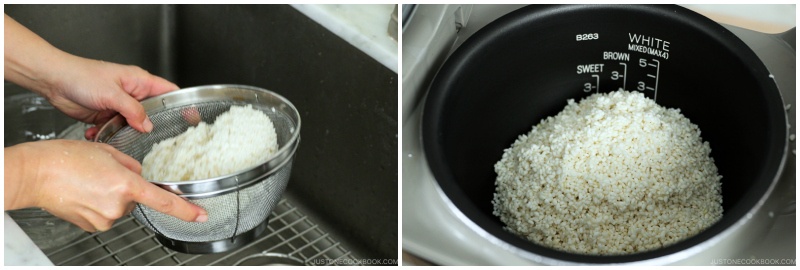
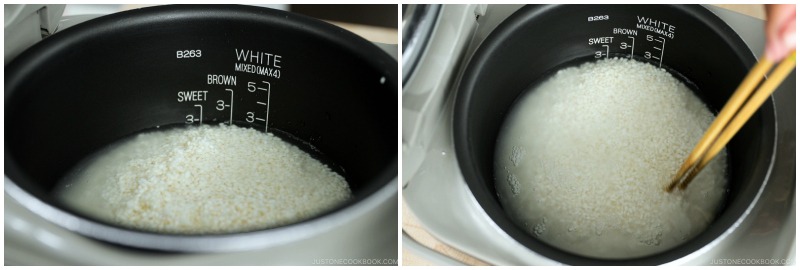
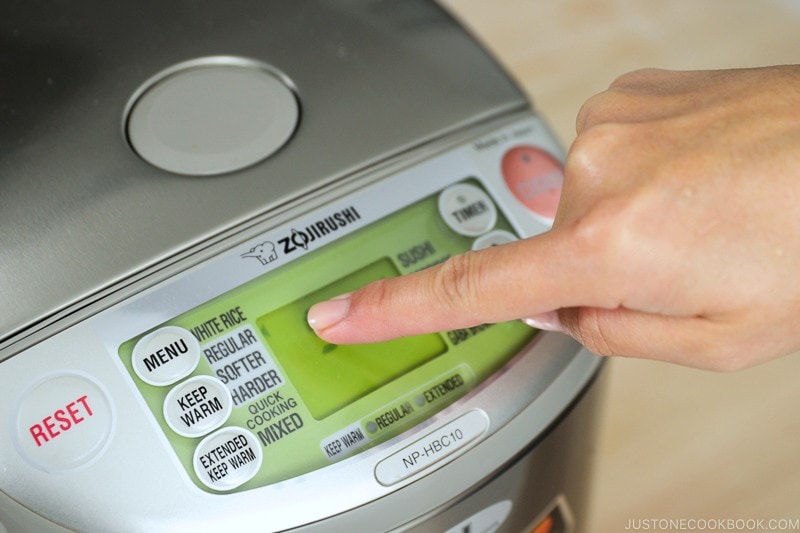

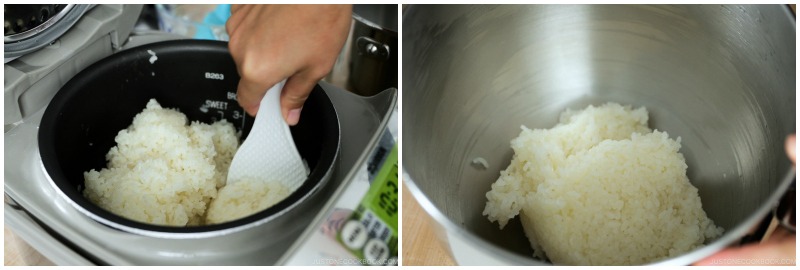
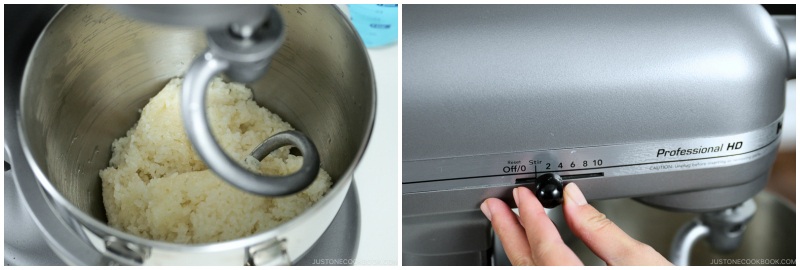
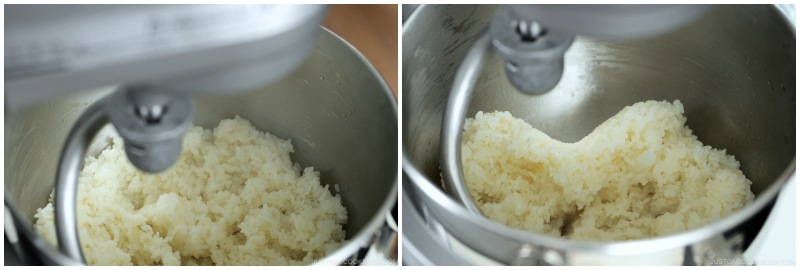
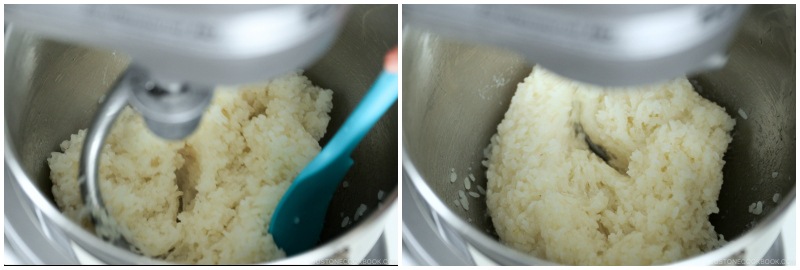
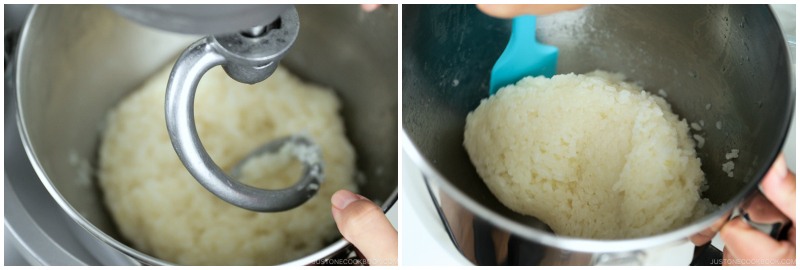
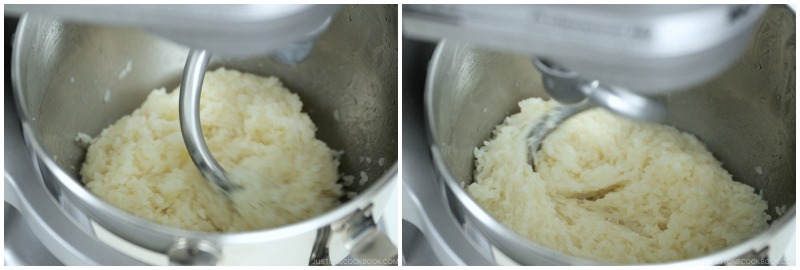
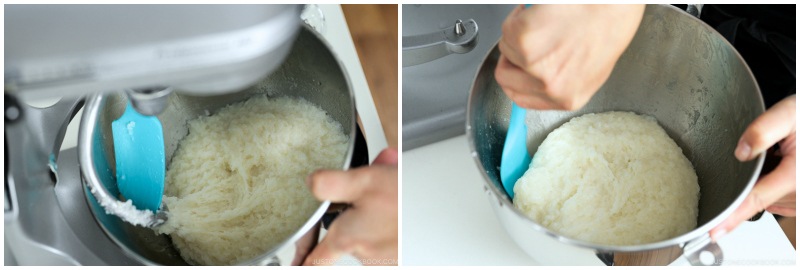
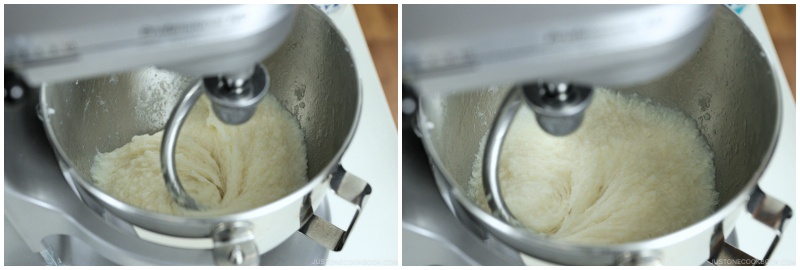
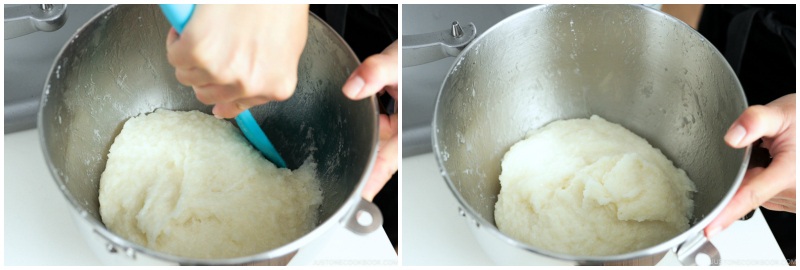
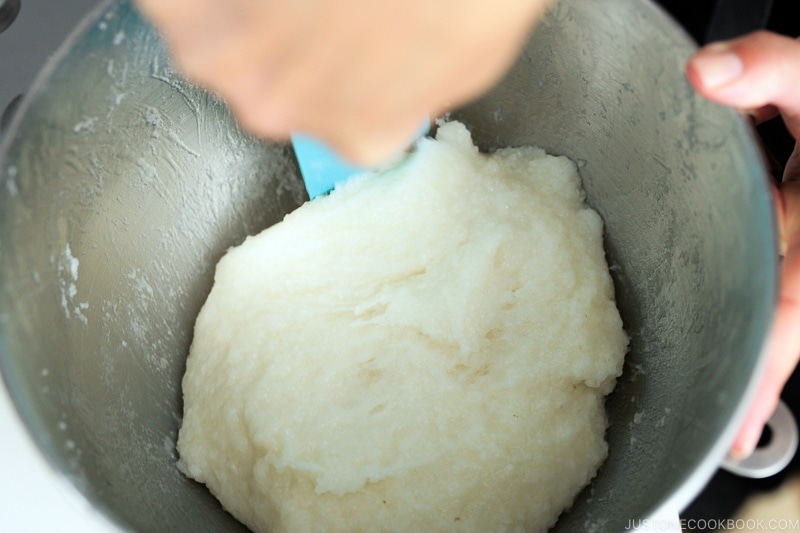
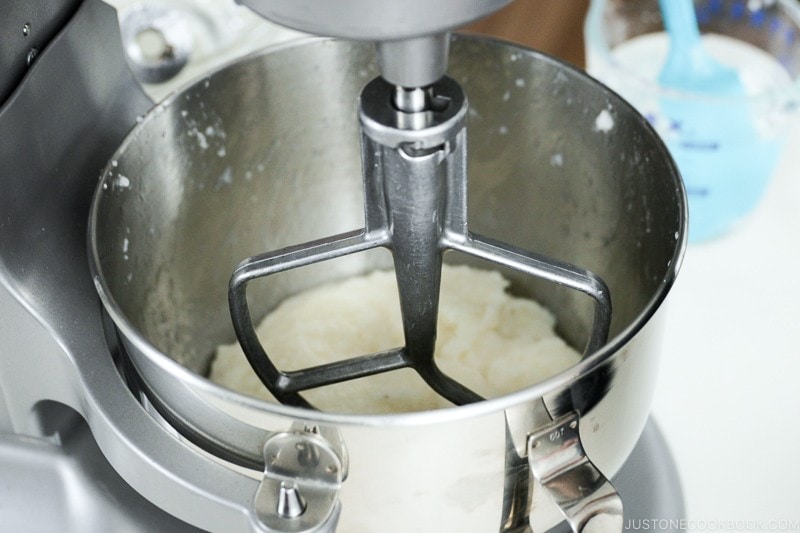
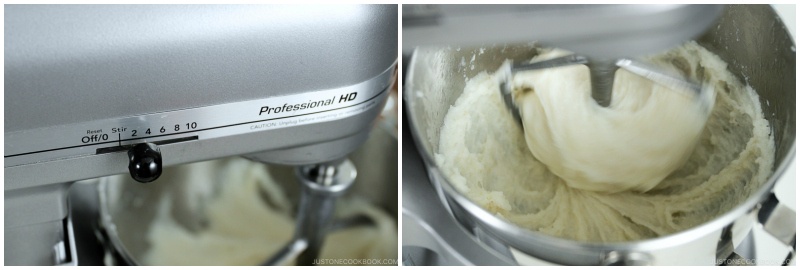

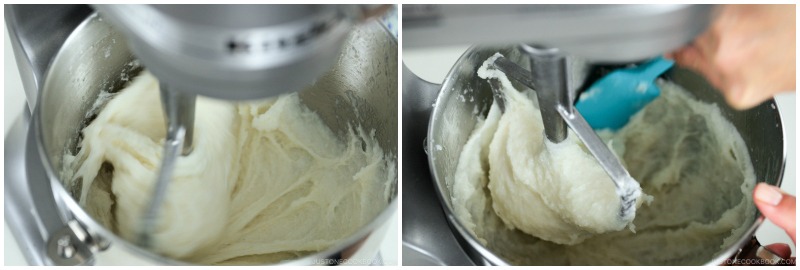
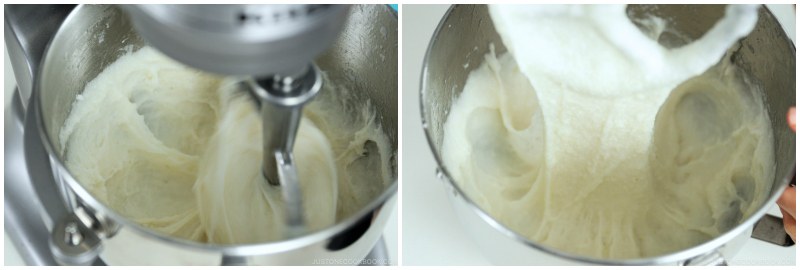
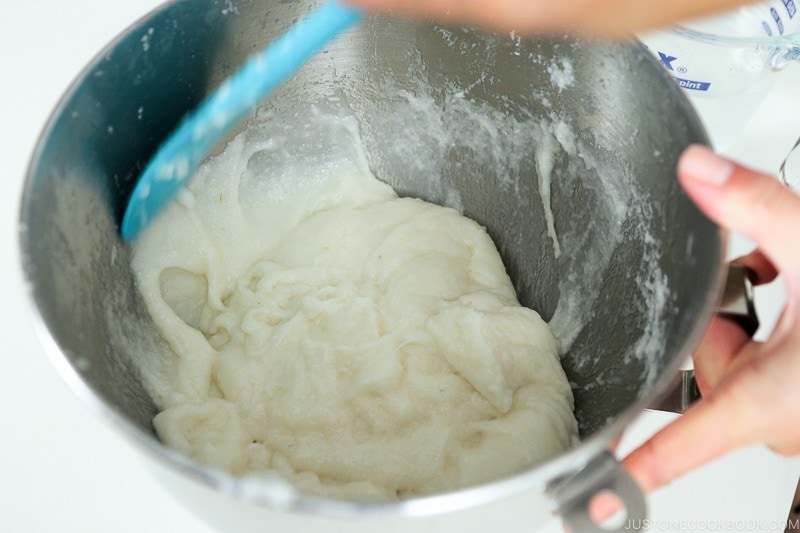
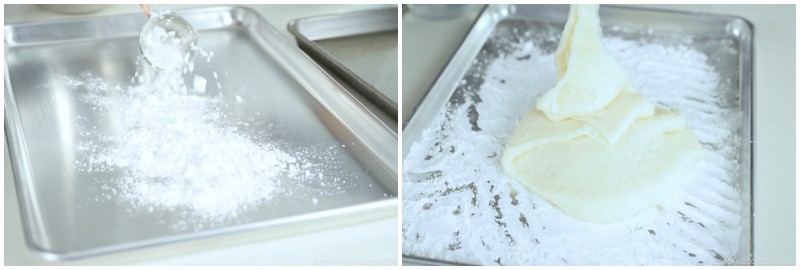
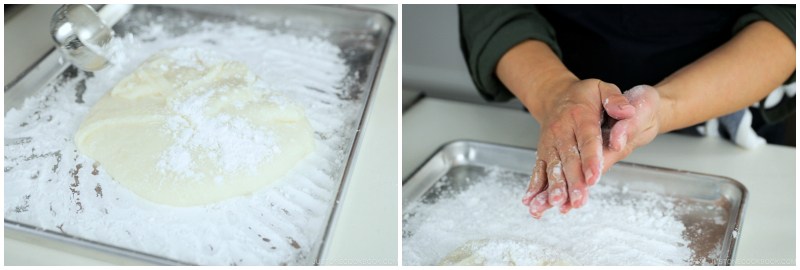
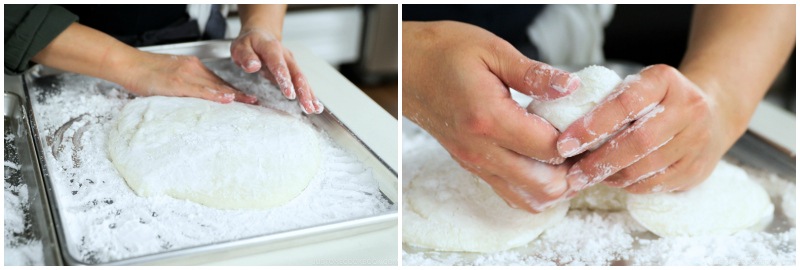
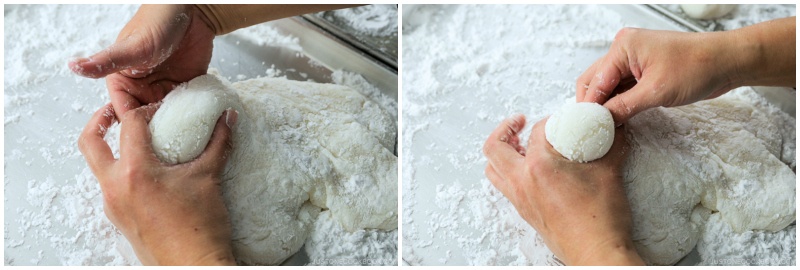
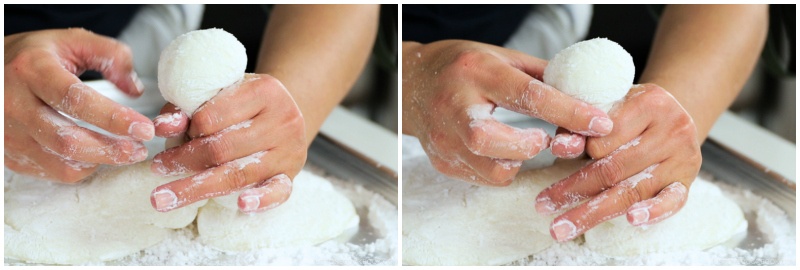
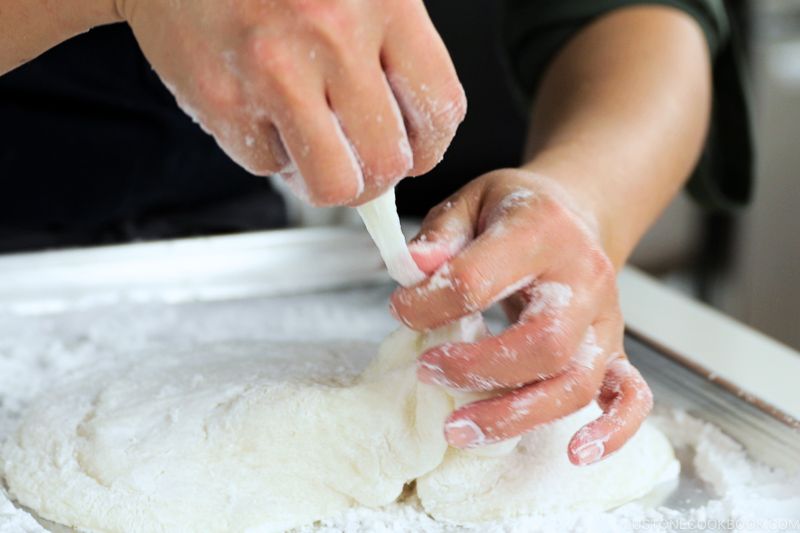

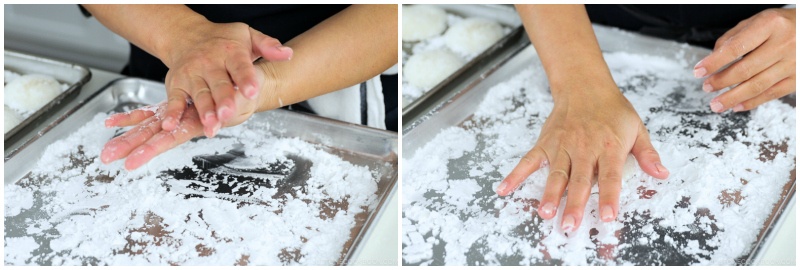
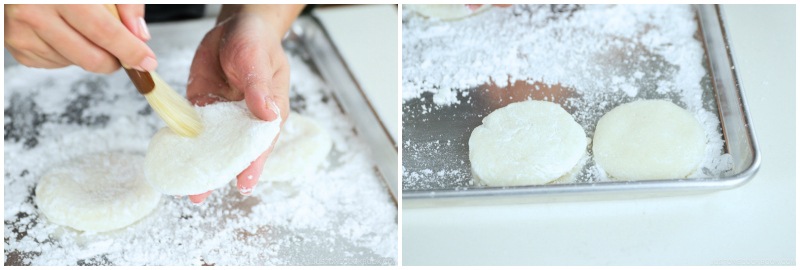
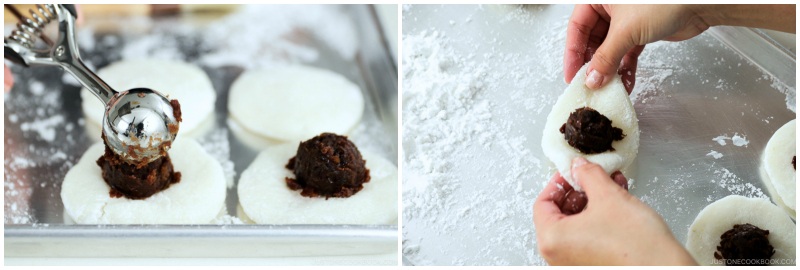
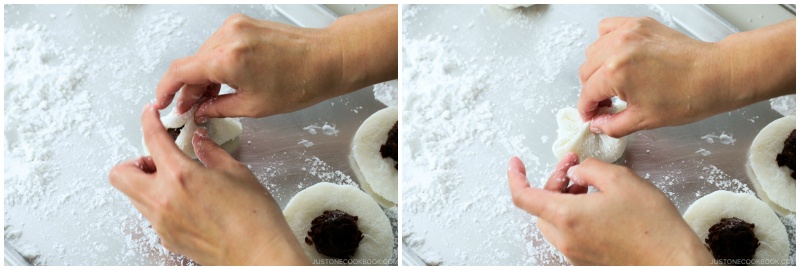
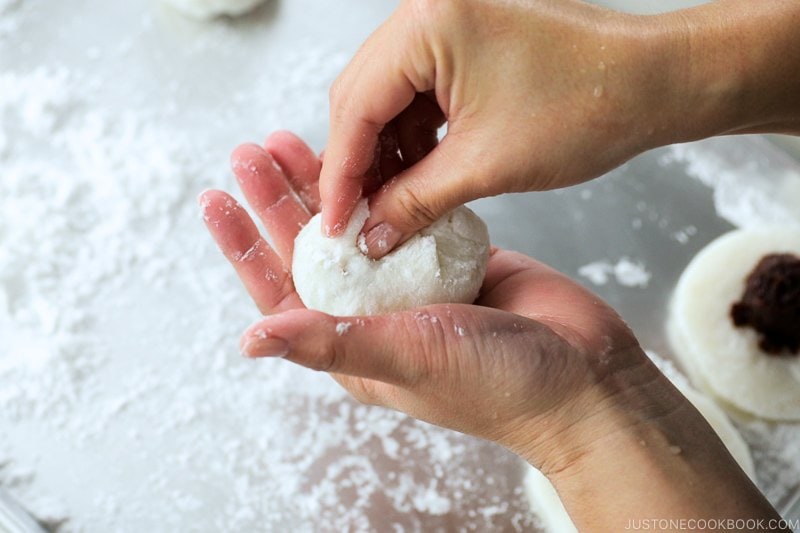
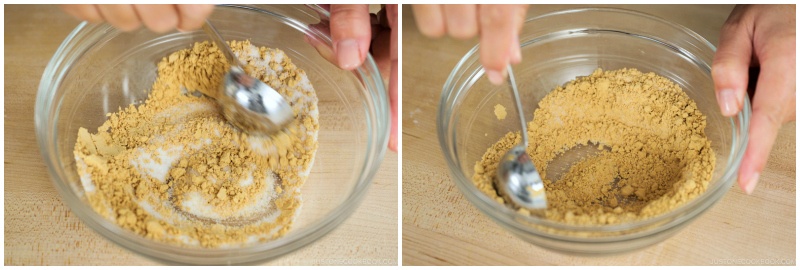
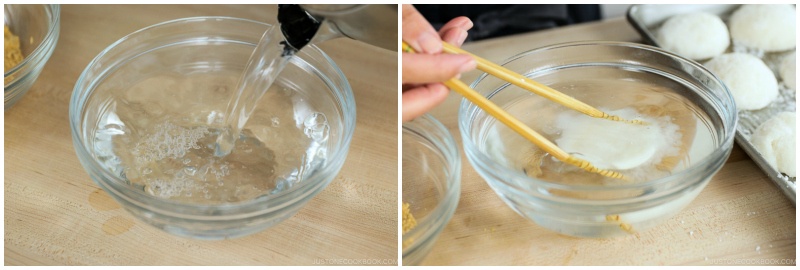
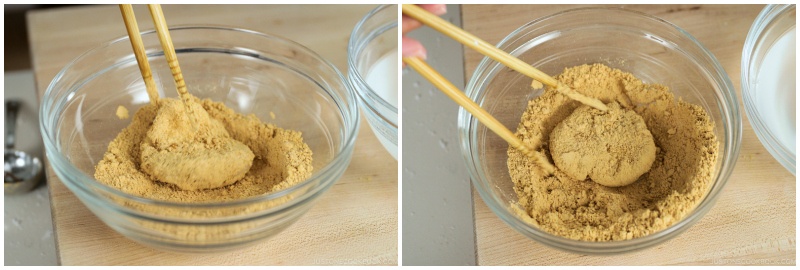










I made this yesterday and it was a huge success. Thank you. I have never made omochi before and even my mother (my harshest critic) raved about it. This will be an annual thing now!
Hi Mayumi!
Thank you very much for trying this recipe and for your kind feedback.
We are so happy to hear it came out great, and everyone enjoyed fresh homemade Mochi!
Happy New Year!🎍
Hi Nami, Thank you for the detailed step-by-step recipe for mochi. Just finished making mochi in prep for New Year’s Day and it looks perfect. My husband just put a couple on the grill and they were delicious. Middle was soft and gooey. Looking forward to sharing it with family in our traditional ozoni. Happy New Year!
Hi Carla!
Yay! We are so happy to hear it turned out great!
Thank you very much for trying this recipe and for your kind feedback.
Have a wonderful New Year!🎍
I don’t have the machines to be able to make mochi, but I love watching it be made. I’m 66 years old and I love that you do this so people can make the delicious Japanese food. I’m half Japanese and lived in Japan on Tachikawa Air force Base before it was given back to Japan. Thank you!!!!
Hi Mary,
Thank you very much for your kind feedback. You made us very happy. 🥰
Yes! We hope many people easily enjoy cooking delicious Japanese food at home!
I’ve got to try this for the new year. Our temple is not selling mochi because of the pandemic. But I wanted to add that my favorite way to enjoy mochi is in ozoni. But leftover ko-mochi is pan fried in butter and rolled in kinako/sugar. Love your recipes and how you explain washoku to the West.
Hi Lori!
Thank you very much for your kind feedback!
We hope you can enjoy freshly made Mochi at home this year.
Thank you for trying this recipe.☺️
Thank you Nami san.I love mochi.your receipe is very undestanding .though i can cook washoku never try mochi as I dint get a easy to do receipe..
When i visit Japan next time ill buy mochi kome to make mochi at home.thank you again
I usually buy freeze-dried mochi for New Years but when I came across this recipe, I wanted to try it. And it came at a perfect timing because my husband just bought me a stand mixer a few months ago. So tried it yesterday, and I am impressed! It is better than freeze-dried mochi, and reminds me of when my mom used to make mochi in our mochi machine when we were growing up. My son loved it, and my husband, who doesn’t even like mochi that much, said it’s the best he’s ever had. Thank you so much!
Hi Akiko!
Yay!😍 Thank you very much for trying this recipe with your new stand mixer!
We are so happy to hear it came out great and tasted better! We couldn’t be happier to know your family had a chance to enjoy freshly made mochi at home and love it! 👏🏻
Thank you for sharing your story and kind feedback!
Question: I was hoping to also be able to make sweet mochi that’s sweet to eat straight (like some storebought here in the states). I assume I should add sugar as I mix the rice into a paste or as I cook it, but how much would you recommend? 1/2 cup sugar for 1 rice cup rice?
Review: I really enjoyed making this! I was looking forward to making this as soon as I got a nice rice maker, and it worked super well. I used Thai sweet glutinous rice (which is longer grain than Japanese mochi rice I think) and it still worked for me if that’s all you can find. If you have an artisan KitchenAid (the tilt head one) like me, you might want to half or even third your batch. A comment on the YT vid for this recommended that, and I found even with halving my batch it was a tad difficult. But in the end I got smooth, super-sticky mochi. Although please don’t make my mistake and decide to wrap anything after letting your mochi sit, especially in the freezer! I did two at first and then decided to do the rest a few hours later, but it made it hard to wrap the ice cream. Make sure to set aside time to do everything as soon as your rice is done in the cooker. You should be fine then!
Hi Jessica!
Thank you very much for trying this recipe and sharing your cooking experience and tips with us.
We have never tried Thai sweet glutinous rice to make Mochi before, so it helps other readers. Thank you!
To make sweet mochi, you may add the sugar when you start mixing the Mochi. 1/2 cup sugar for 1 rice cup rice seems to us a little too sweet, but it’s totally up to your preference.😉
We participated in major Japanese Athletic League Mochitsuki Fundraisers for many years. We produced literally over a ton (2,000 lbs) of Mochi each year. We soaked the rice overnight, drained and steamed the rice, then used a commercial meat grinder to create the smooth consistency of mochi (sometimes grinding it twice).
I have the meat grinder attachment for the Kitchen Aid Mixer. I have always felt that it would do the job of grinding/pounding the cooked rice. Have you tried using the meat grinder? It was simpler than dough hooks and paddle attachment. Plus it produces a very smooth consistency if you grind the cooked rice twice. w
Just be sure to wash the grinder/parts in hot soapy water right away or the ground rice hardens like cement inside the grinder attachment – which would be a nightmare to clean.
Hi Teresa!
Wow! 2,000 lbs of Mochi!? That is a big job! You are amazing!
We have not tried the meat grinder attachment. But we can imagine that it may do a better job.
Thank you very much for sharing your story and cooking tip with us!☺️
I was planning to make Mochi and stumbled across your recipe I made the dough but it was super sticky I couldn’t mold it no matter how much cornstarch I put. I used long grain instead of short grain Idk if that made a difference I just ate in with some red bean paste still tasted nice tho could you please explain why it was super sticky
Hi Jess!
Thank you very much for trying this recipe!
Homemade Mochi is very sticky, and it gets harder quickly, so you have to make a shape very quickly. Making the C shape with your left pointing finger (Step 4) is the easiest way to shape the mochi. (You can also see how Nami did it on Youtube. https://youtu.be/zfBGFsp0Krw )
We hope this helps!
This was very helpful. I’m getting better after a few tries of trying to mold it in my hand. Looking for your video on how to hold the C-shape finder trick. I love my mochi maker. After soasking, I go from steaming to finished product in just over an hour. Very meditative.
Hi David!
We are so glad to hear that the video was beneficial for you!
Thank you for your kind feedback.🙂 P.S. I love my mochi maker too.😁
Hi! Thank you so much for this recipe. For the best tasting mochi ice cream would you recommend buying a mochi machine or using a stand mixer? Thank you so much!
Hi Shea!
If you would like to make the best tasting Mochi Ice Cream, we recommend making mochi using Shiratamako. It will be a different process of making mochi, and you don’t need a mochi machine or stand mixer.
Here is the recipe for Mochi Ice Cream;
https://www.justonecookbook.com/mochi-ice-cream/
We hope this is helpful.😉
Hi Nami,
I used a mortar and pestle (just a small one from Spain, not the traditional Japanese kind) to pound the rice by hand. The mochi is delicious. I just have a question: Do you have any recommendation for how to get the sticky mochi off the mortar when washing? Thank you for all your lovely recipes.
Hi Amalia! Wow I’m so happy to hear you made mochi in the Spanish mortar pestle! Really cool! After you are done with pounding, immediately soak. What material are your mortar and pestle?
Hi Nami,
The mortar is ceramic and the pestle is wood. I was able to wash everything off after soaking in cold water, but next time I will soak immediately.
Thank you!
Hi Amalia! Thanks so much for letting me know! Good to hear it comes off. Rice usually comes off cleanly when it’s soaked enough. It’s usually better you let it soak for a long time before you try to wash. 🙂
Hi Nami – I love your site, I have made a few of your recipes with much success and now I will try to tackle this one 🙂 If I wanted to grill my mochi though, how long should I be leaving it out to dry? And should I leave it out uncovered? Thanks so much!
Hi Janice! So sorry for my late response. We usually leave it out overnight, (after cool down you can cover, but not while it’s warm because we don’t want condensation) and once it’s hard, we can wrap individually and put in ziploc bag to freeze. I mentioned in the blog post but it’s a pretty messy project. Good luck! 😀
Hi Nami,
How would you alter this recipe to make kirimochi-style mochi? I am craving the grilled mochi and since I’m used to only having it in those individually packed bags I reckon it’s something most folks don’t make at home. I hope maybe that’s not true and I can try it out!
Hi Mary, We have never tried to make Mochi like the ones in the individual package bags, and we are not sure how to alter this recipe. You can try adding the cooked Joshinko and Shiratamako, like making Dango. https://www.justonecookbook.com/mitarashi-dango/ We hope this helps!
Used brown sweet rice! The texture is gritty and the colour is not as pure But I enjoyed it a lot! Very tasty with maple syrup :p
Hi YiChen! Ohhh you used the brown sweet rice! I don’t think I’ve seen it before! I wonder if the gritty texture is even more for brown rice. The white rice also gets gritty (as there is no REAL pounding motion with the stand mixer), but not too bothering (and you can probably see in my pictures). 🙂
I made this! And it was yummy! I made two batches, once exactly the way it is written, but the 2nd time I added .25 cup of sugar to the rice mixture. It just added a hint of sweetness to the mochi.
I borrowed my friend’s Kitchen Aid stand mixer, but after watching the consistency, I think I can use a combination of a food processor (it has dough blades) and my stand mixer that is on the fritz (it only holds one attachment because the hole for the other attachment is loose. I did notice that when I added in the sugar, the batter got “tougher” and I could hear the motor begin to struggle so I stopped it before the full 3 min. Didn’t want to ruin my friend’s mixer, and our friendship to boot!
Hi Karen! Thank you so much for trying this recipe and for your kind feedback! Thanks for sharing your tip on a food processor. I haven’t done it, so that was helpful. Sugar to the mochi is not only adding sweetness, but it also keeps the mochi stay tender/softer. Typically mochi gets hard, but by adding the sugar, it gives more moisture and stay chewy and soft. 🙂 Store-bought mochi is really nice and soft for a long time because of high sugar in mochi.
Thank you again!!!
Maybe we could make the sugar into a syrup before adding?
Hi,
I just tried your daifuku recipe with shiratamako, very easy and very good. I was not sure about the sugar but it was a great proportion of sugar and shiratamako.
Now I will like to try this version. I was wondering why there is no sugar in this version of mochi ? And if sugar is to be added, how much will you recommend for obtaining a similar taste to your shiratamako recipe?
Thanks !
Hi Ricardo! Sugar is included in the sweet mochi recipe not only for sweetening but also to keep the mochi soft and tender the next day (otherwise it’ll be rock hard). 🙂
For this recipe, we actually harden the mochi overnight to dry out and then once dry and not sticky, we wrap individually and freeze. This is Kiri Mochi and we use it for savory New Year Soup. Or we use this to make Kagami Mochi decoration (https://www.justonecookbook.com/kagami-biraki/) for the new years. When we say mochi, usually we make these plain mochi for the New Years.
So if you use this recipe for the sweet daifuku mochi, you should add sugar. I googled and found out for 100 g cooked/pounded mochi, you need 50-100g sugar if you are making daifuku mochi. I recommend adding 50 g first, then slowly add more. More sugar you added, mochi stays softer for a longer time. 🙂
😮😮😮 Thanks a lot !!
I used less than that 1:1 ratio and it ruined my mochi and I had to throw it out. T_T It became translucent and wouldn’t stick together anymore, more like slime than anything else, and WAYYYYY too sweet. For 200g of mochigome (only two rice cooker cups, as I have a smaller rice cooker), I used maybe 175g of sugar, probably closer to 150g, and it was so disappointing.
Hi Erin! I’m sorry to hear this. I shared the information above to the previous commenter from the information I learned online:
https://www.surugaya.co.jp/fureai/answer/ans_0109.html (Please use Google chrome and translate to English)
This info is from the professional Wagashi maker.
As you see in this recipe, I never added sugar because I use this mochi for savory food (New Year Mochih Soup), and if I use this fresh mochi to make sweets, the other ingredients (red bean paste or soybean flour) are sweetened so I don’t need to sweeten the fresh mochi itself.
Only disbenefit of not adding sugar is that mochi gets hard without sugar inside, but we only eat FRESH mochi (dessert) right away, so I don’t worry about keeping it for the next day. If you want to keep the mochi dessert till next day, I’d use my Daifuku Mochi recipe instead of this fresh mochi recipe.
Now, in Japan, most Daifuku Mochi is made with glutinous rice flour. And this “mochi” skin for mochi dessert is actually called Gyuhi 求肥 in Japan. It’s a bit too much info (and not well-known terminology) so we say “mochi” in English but practically it’s a different thing in Japan. So when Japanese say mochi, it typically implies this fresh mochi (with no sugar) that we use for non-sweet recipes, and all the wagashi sweets are made with Gyuhi.
Gyuhi made with glutinous rice flour (Shiratamako or Mochiko) also requires sugar. For my Daifuku or any “mochi dessert” recipes on the website, I use sugar, and the ratio is 1 (sugar) : 2 (glutinous rice flour). So if it’s 100 g glutinous rice flour, I use 50 g sugar. I need this Gyuhi to be soft next a few days so sugar is inevitable. Sugar turns to the moisture in the mochi and maintains softness. In Japan, we add Mizuame (a kind of sugar syrup) on top of sugar, but it’s hard to get here in the US (we can get one brand at a Japanese grocery store), so I do not include in the recipe.
As I mentioned above (and to the previous commenter), sugar is necessary to keep the mochi soft for a long time, and 1:2 is pretty standard.
I’m not sure what recipes you needed to sweeten the fresh mochi, but I’m really sorry it was disappointing. For my website, I try to provide my recipes as authentic as possible but I understand it may not work for everyone. I’m sorry you had to throw away.
Next time, maybe you can follow my recipe exactly without sugar included. Please let me know if I can give you more advice. 🙂
That is super helpful, thank you! I’ll be trying that today, hopefully I can get it down this time!
Hi Erin! Keep me posted and good luck!
Hello !
So I tried adding sugar (50g of sugar for 100 g of uncooked rice). It is not bad, although I will tried next time with less sugar as I would like it to be less sweet.
At the end I didn’t succeed, but I think the problem was that I only used 150 g of uncooked rice, which seems not to be enough for the stand mixer for this recipe to work. So, second note, I confirm that the best it’s to respect the proposed quantities in your receipe.
I was wondering, have you ever tried using only the flat batter, or using the flat batter first and the hook ?
For making daifuku, the easiest way is the shiratamako path without a doubt ^^
Hi Ricardo! Thank you for trying my recipe! Ah I see… yeah without substantial amount, it may not pick up the rice/mochi with the hook. I agree, if you have Shiratamako, that’s what we usually use to make daifuku. This one is to make mochi (we can’t use shiratamako to make mochi).